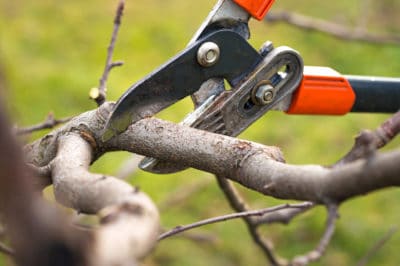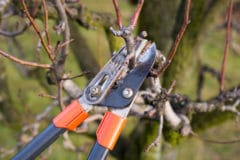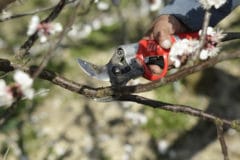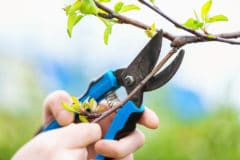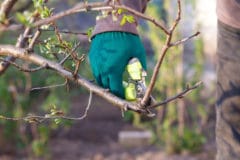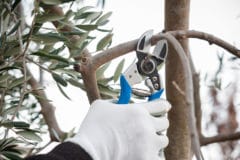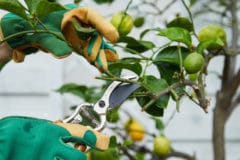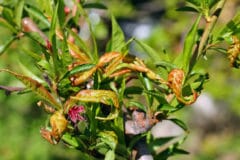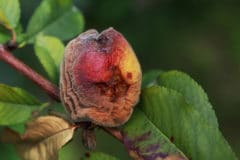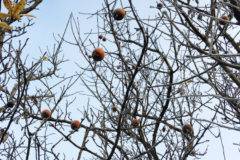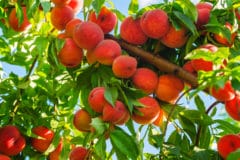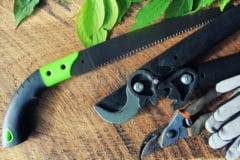Why You Should Prune Your Peach Tree
An unpruned peach tree is a sorry sight. By not removing some of the branches, a peach tree becomes unhealthy, overgrown, and stops producing fruit. If you don’t prune your peach tree, the amount of fruiting wood decreases each year along with the peach harvest.
Pruning also removes diseased and broken branches, and this makes it less likely the tree will succumb to one of the fungal or bacterial problems common with this type of fruit tree.
Pruning a peach tree also keeps the tree from growing too tall and making harvesting difficult. In addition, by removing some of the branches, you allow more air circulation and sunlight to enter the interior of the tree, giving the tree the energy it needs to produce large and tasty peaches and cutting down on disease problems.
When to Prune a Peach Tree
Prune your peach tree in the spring, but wait until rainy weather is over because rain can spread diseases in the tree when it falls near the time of pruning.
Frost is another concern to be aware of when it is time to prune. A frost soon after pruning can damage the tree. The tree needs a period of mild, dry weather to heal after it has been trimmed.
Many people prune their peach trees just before or as the tree starts to show tight, pink blossoms. Pruning at this stage has the advantage of letting you clearly see which branches are alive, healthy, and vigorously growing and which are not.
In most areas where peaches grow, these trees are pruned in February or early March.
How to Prune a Peach Tree
Peach trees produce fruit on wood which is one year old. Branches and twigs older than this no longer produce fruit, so a main element in pruning is removing the old fruiting wood so the tree can devote its energy to fruitful, new growth.
Old fruit wood looks grey and grows slower than new wood. When you prune, look for fast growing, reddish colored branches that are 18 to 24 inches (45 to 60cm) in length, and leave these, trimming out the older wood.
Peach tree pruning involves removing up to 40 percent of the tree’s branches each year. This may sound like a lot, but cutting out this old wood is the only way of stimulating new growth and plenty of fruit.
You only need a few tools to prune a fruit tree. These are:
- A pair of small, by-pass pruning shears for small branches.
- A large pair of loppers for cutting large diameter branches.
- A pruning saw for cutting out the largest branches and the hard wood of dead branches.
- An orchard ladder or an extension pruning shear for reaching the upper levels of the tree.
- Protective clothing, such as long-sleeved shirt, sturdy work shoes, goggles, and gloves.
Make sure your tools are sharp and in good condition before you start, and clean tools thoroughly before and after you are done to avoid spreading diseases.
Heading Cuts and Thinning Cuts
An important point to understand in pruning peach trees is the difference between a thinning cut and a heading cut.
Thinning Cuts
Thinning cuts remove entire branches at their base, and the branch does not grow back after making this type of cut. This is the cut to use for removing wood so that sunlight can enter the interior of the tree and for removing crossing, diseased, and damaged branches.
Heading Cuts
Heading cuts are made somewhere along the length of a branch just before a bud. These cuts stimulate growth behind the cut, resulting in more vegetative growth.
Follow these steps when pruning your tree:
- Cut out any water-sprouts growing up from the root stock or the base of the tree.
- Cut out old fruiting wood in the upper part of the tree, leaving the new, reddish branches. Make these cuts at the base of the branch and do not leave a stub.
- Remove branches which cross or grow toward the interior of the tree and any branches with signs of disease or damage.
Additionally, prune to shape the tree, leaving branches growing upward at a 45 degree angle. This maintains a strong branch structure to carry the weight of all those delicious peaches.
